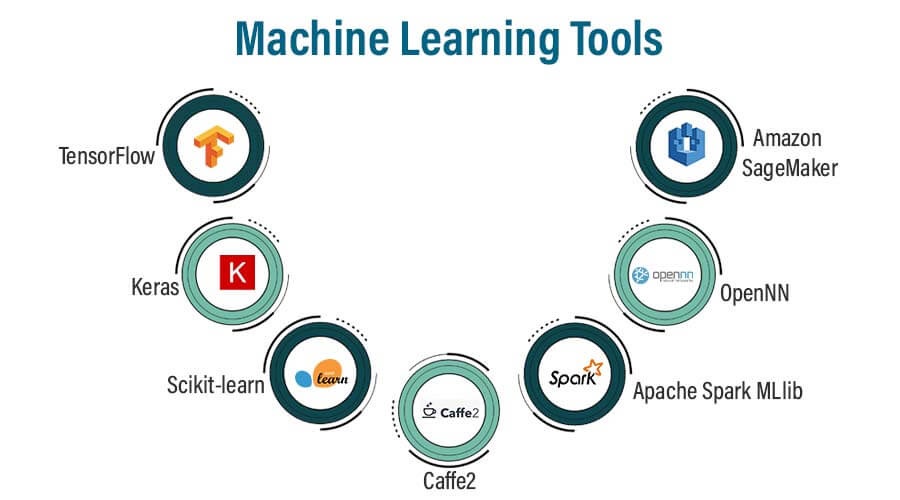Welcome to the fascinating world of machine learning (ML) in software development! As we delve deeper into the digital era, ML tools have become pivotal in transforming how we develop, optimize, and manage software. Whether you’re a seasoned developer or just starting, integrating ML into your workflow can propel your projects to new heights of efficiency and innovation. Let’s explore the top 8 machine learning tools that are reshaping the landscape of software development.
1. TensorFlow: The Powerhouse of Machine Learning
TensorFlow, developed by Google Brain, stands as one of the most widely used machine learning frameworks in the industry. Renowned for its flexibility and scalability, TensorFlow empowers developers to create a broad spectrum of machine learning models, ranging from simple linear regressions to complex deep neural networks. Its rich ecosystem includes high-level APIs like Keras, enabling rapid prototyping and seamless deployment across various platforms. TensorFlow’s versatility makes it suitable for diverse applications, including image recognition, natural language processing, and reinforcement learning.
2. Scikit-Learn: Simplicity Meets Elegance
Scikit-learn stands as a cornerstone of the Python machine learning ecosystem, offering a comprehensive suite of algorithms and utilities for data preprocessing, modeling, and evaluation. Its user-friendly interface and extensive documentation make it an ideal choice for beginners and seasoned practitioners alike. From traditional classifiers like support vector machines and decision trees to modern ensemble methods like random forests and gradient boosting, Scikit-learn provides a versatile toolkit for tackling classification, regression, clustering, and dimensionality reduction tasks. Moreover, its seamless integration with other Python libraries fosters a vibrant ecosystem of data science tools and frameworks.
3. PyTorch: Dynamic and Intuitive
PyTorch, an open-source machine learning library spearheaded by Facebook AI Research, has gained significant traction among researchers and developers alike. What sets PyTorch apart is its dynamic computational graph, which facilitates intuitive model development and debugging. With its Pythonic interface and extensive support for GPU acceleration, PyTorch excels in scenarios requiring rapid experimentation and algorithmic innovation. From convolutional neural networks for computer vision to recurrent neural networks for sequential data analysis, PyTorch empowers developers to tackle a wide range of machine learning tasks with ease.
4. Keras: High-Level Neural Networks API
Keras, a high-level neural networks API written in Python, abstracts away the complexities of low-level tensor operations, allowing developers to focus on model architecture and experimentation. Built on top of TensorFlow, Theano, or Microsoft Cognitive Toolkit (CNTK), Keras offers a user-friendly interface for designing and training deep learning models. Whether you’re building convolutional neural networks for image classification or recurrent neural networks for sequence modeling, Keras streamlines the development process with its modular design and intuitive API. Its emphasis on simplicity and extensibility has made it a popular choice among researchers, educators, and industry professionals alike.
5. Apache Spark MLlib: Large-Scale Machine Learning
Apache Spark, a fast and general-purpose cluster computing system, has emerged as a leading platform for large-scale data processing and analytics. At the heart of Spark lies MLlib, a scalable machine learning library that leverages distributed computing to train models on massive datasets. MLlib provides implementations of popular machine learning algorithms, such as logistic regression, k-means clustering, and collaborative filtering. By harnessing the power of Spark’s resilient distributed datasets (RDDs) and DataFrame abstraction, developers can build end-to-end machine learning pipelines that scale seamlessly across distributed clusters.
6. Microsoft Azure Machine Learning: Cloud-Based Solution
Microsoft Azure Machine Learning offers a cloud-based platform for building, training, and deploying machine learning models at scale. With its rich set of tools and services, Azure Machine Learning caters to the diverse needs of data scientists, developers, and IT professionals. From automated ML for model selection and hyperparameter tuning to advanced deep learning capabilities with Azure ML Studio, developers can leverage a wide range of features to accelerate their AI initiatives. Moreover, Azure’s robust infrastructure and integration with popular development tools make it a preferred choice for organizations seeking to harness the power of cloud-based ML.
7. Amazon SageMaker: Streamlining ML Workflows
Amazon SageMaker, a fully managed machine learning service from Amazon Web Services (AWS), simplifies the process of building, training, and deploying ML models at scale. With SageMaker, developers can access a wide range of built-in algorithms and frameworks, including TensorFlow, Apache MXNet, and Scikit-learn, to accelerate model development. Moreover, SageMaker’s automated model tuning capabilities and elastic training infrastructure enable developers to optimize model performance and reduce training costs. Whether you’re building recommendation systems for e-commerce platforms or fraud detection models for financial institutions, SageMaker provides a scalable and cost-effective solution for deploying AI in production.
8. RapidMiner: Comprehensive Data Science Platform
RapidMiner is a comprehensive data science platform that offers an integrated environment for data preparation, machine learning, deep learning, text mining, and predictive analytics. It’s known for its user-friendly graphical interface that allows developers to create, deliver, and maintain predictive models without deep programming knowledge.
Conclusion
As machine learning continues to evolve, these tools offer developers unparalleled opportunities to innovate and streamline their software development processes. By leveraging the strengths of these ML tools, you can unlock new potentials in your projects, from automating routine tasks to creating more intelligent, adaptive software solutions. Embrace these tools and be part of the exciting journey of transforming the software development landscape with ML!



